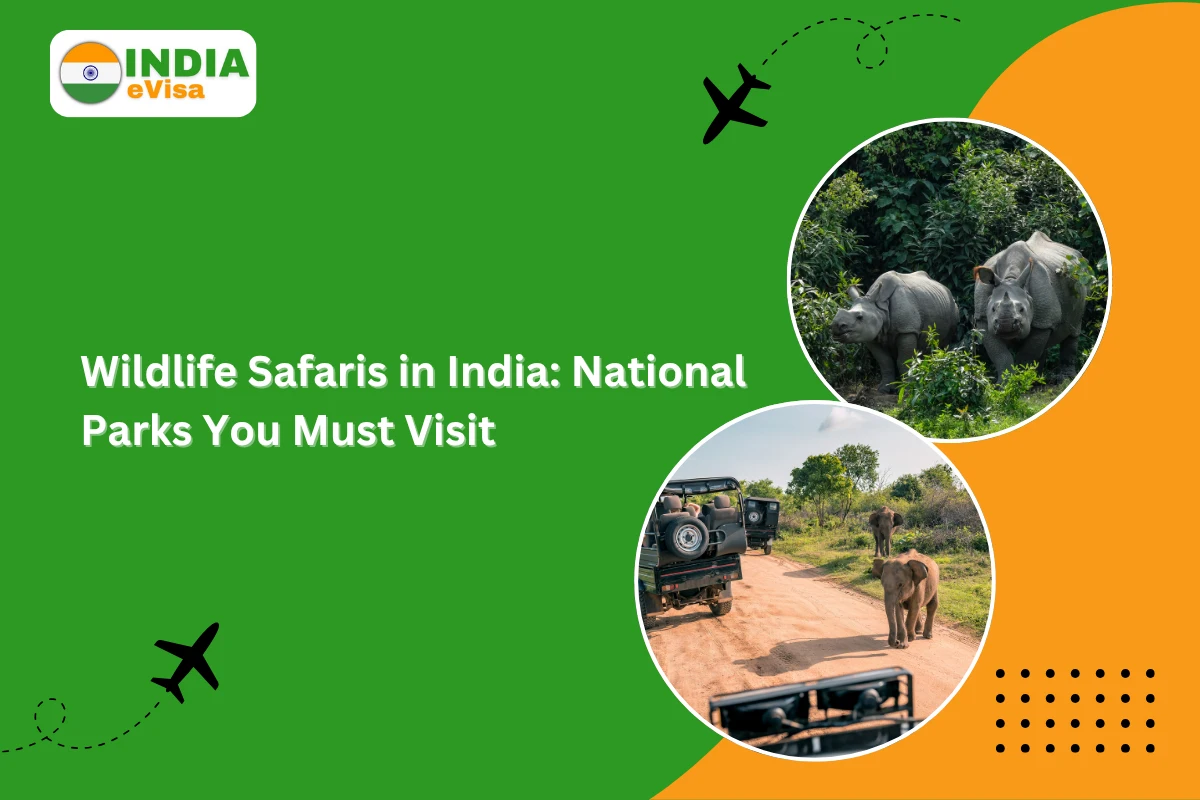Wildlife Safaris in India: National Parks You Must Visit

Have you ever imagined yourself deep in a quiet forest, hearing leaves rustle underfoot, or spotting a tiger stepping into view? That’s what Wildlife Safaris in India feel like. These journeys connect you with nature, local culture, and conservation—making each india safari a heart‑warming adventure. With the ease of India Visa Online and clarity around India Visa Fees, planning is smoother than ever. Let’s explore the best parks and everything you need to know for a memorable wildlife trip.
Why Wildlife Safaris in India Are So Special
India has over 100 national parks and 58 tiger reserves, protecting a vast variety of wildlife—more than 75% of the world’s wild tigers live. Each Wildlife Safari in India offers a unique landscape—from misty forests in Madhya Pradesh to wetlands in Assam, dry scrublands in Rajasthan, and green jungles in South India. You may see Bengal tigers, elephants, one‑horned rhinos, Asiatic lions, leopards, deer, sloth bears, and hundreds of bird species.
More than just wildlife, these trips let you feel the mist at dawn, breathe fresh air, hear birdsong, and learn local stories that make your journey unforgettable.
Top Parks to Experience Wildlife Safaris in India
Here are top destinations for Wildlife Safaris in India:
1. Bandhavgarh National Park, Madhya Pradesh
Bandhavgarh is known for the highest tiger density in India, with about 135 tigers recorded in the core area. Resorts like Oberoi Vindhyavilas combine tribal culture with luxury to elevate your safari stay.
2. Kanha Tiger Reserve, Madhya Pradesh
Kanha inspired The Jungle Book. It hosts tigers, barasingha deer, leopards, sloth bears, and more than 300 bird species. Many visitors describe the early morning meadows as magical.
3. Kaziranga National Park, Assam
Famous for one‑horned rhinos (2,200+ in population) and now with 148 tigers as of the 2024 survey, Kaziranga ranks third in tiger density in India (18.65 tigers/100 km²), behind Bandipur and Corbett. Expect rhinos, elephants, swamp deer, and rich birdlife.
4. Bandipur & Nagarhole Reserves, Karnataka
These create a wildlife corridor offering dense jungles and open grasslands. Bandipur leads India in tiger density (19.83/100 km²), with Nagarhole offering excellent sightings.
5. Jim Corbett National Park, Uttarakhand
India’s oldest national park, Corbett is home to approximately 260 tigers, over 1,100 elephants, and around 580 bird species. The Dhikala and Dhela zones offer great sighting chances and unique overnight stays.
6. Tadoba Andhari Tiger Reserve, Maharashtra
Tadoba has grown from about 87 tigers in 2022 to nearly 93 in 2023, nearing 100 by 2024 It’s quieter, intimate, and ideal for eco‑travelers seeking raw wildlife moments.
7. Gir National Park, Gujarat
Gir is the only home of the wild Asiatic lion. You’ll also see leopards, hyenas, crocodiles, and many birds—making Gir a rare india safari spot.
When to Go
The best time for Wildlife Safaris in India is October through April. During this dry season, animals gather at waterholes, visibility is better, and the weather is pleasant. Avoid monsoon months (July–September), when many parks close due to poor conditions.
How to Plan Your Safari
Book Permits Early
Secure safari permits online well in advance—popular parks like Ranthambore and Bandhavgarh fill quickly.
Apply for Your Visa
Use India Visa Online and check the India Visa Fees for your nationality to avoid last-minute delays.
Take Multiple Drives
Don’t expect to spot a tiger on the first drive. Safaris recommend 2–3 attempts per park to improve chances of wildlife sightings.
Hire a Local Guide
Good guides track animals, share nature stories and make your Wildlife Safaris in India more meaningful.
What to Expect on Safari
- Early-morning drives bring dew-laced air, mist, and animals on the move.
- Jeep or gypsy rides keep groups small (6–8 people) for flexibility and better viewing .
- Respect rules: stay quiet, avoid sudden movement, and never exit vehicles. Dress in muted colors like olive or khaki to blend in and respect wildlife.
Personal Moments in the Wild
Picture this: In Bandhavgarh at dawn, your guide sees fresh pugmarks. Moments later, a tiger emerges quietly, pauses in a clearing, then melts back into the forest. In Kaziranga, rhinos splash near the grasses under early sun. In Corbett’s Dhikala zone, elephants wander by as birds call from high branches. These are the kinds of experiences only Wildlife Safaris in India can deliver.
Final Thoughts
Wildlife Safaris in India are more than vacations—they are transformative. You’ll see wildlife, learn conservation stories, and feel a deep connection with nature. With India Visa Online making travel easier and clear India Visa Fees, visiting these parks from anywhere in the world is simpler than ever.
So pack your bag, charge your camera, and step into the wild side of India—your Wildlife Safari in India is waiting.
